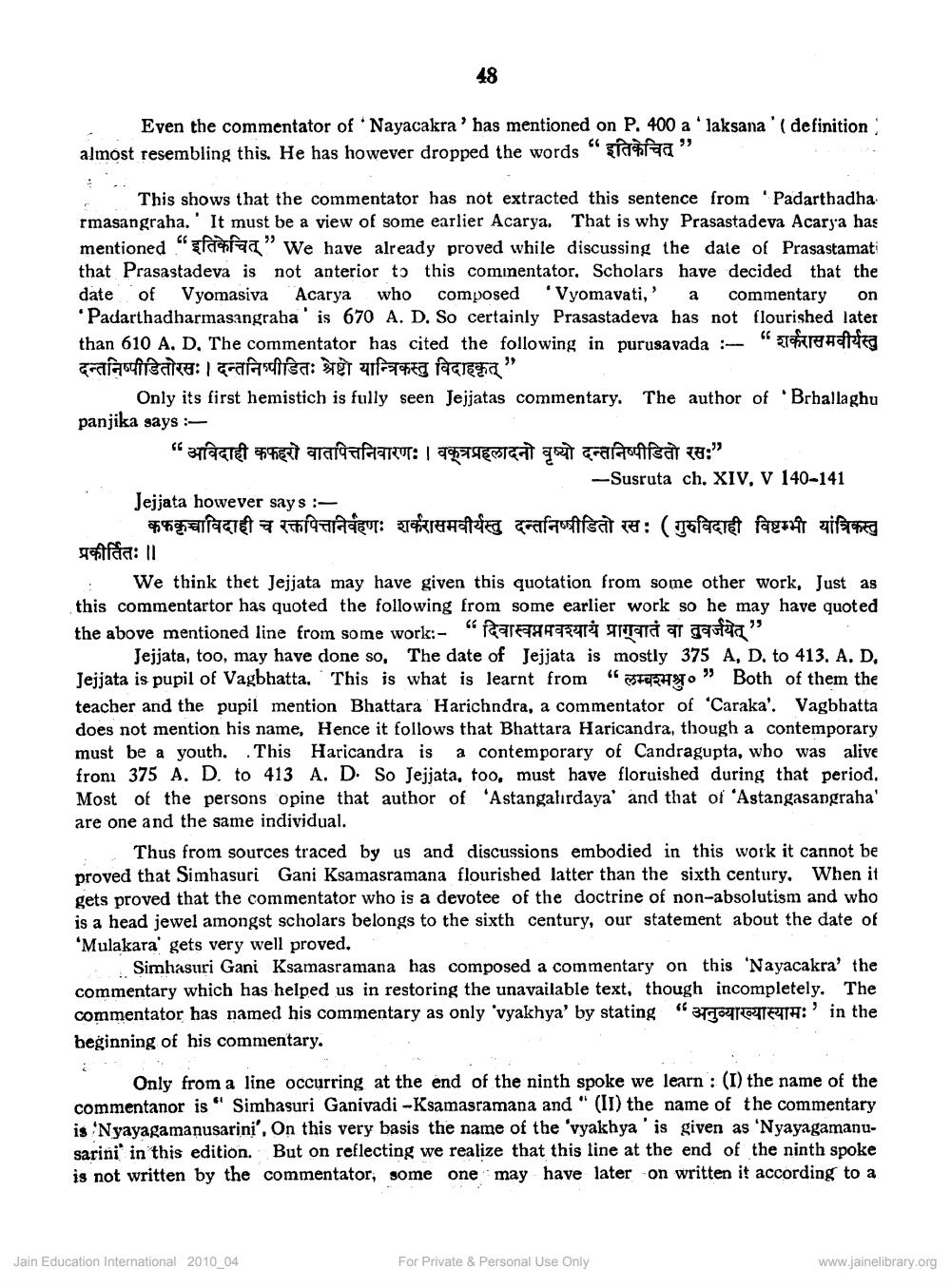________________
48
Even the commentator of Nayacakra' has mentioned on P. 400 a 'laksana (definition almost resembling this. He has however dropped the words "fa"
**
This shows that the commentator has not extracted this sentence from Padarthadha rmasangraha. It must be a view of some earlier Acarya. That is why Prasastadeva Acarya has mentioned "fa" We have already proved while discussing the date of Prasastamati that Prasastadeva is not anterior to this commentator. Scholars have decided that the date of Vyomasiva Acarya who composed Vyomavati,' a commentary on 'Padarthadharmasangraha is 670 A. D. So certainly Prasastadeva has not flourished later than 610 A. D. The commentator has cited the following in purusavada :-- "शर्करामवीर्यस्तु दन्तनिष्पीडितोरसः । दन्तनिष्पीडितः श्रेष्टो यान्त्रिकस्तु विदाहकृत्'
39
Only its first hemistich is fully seen Jejjatas commentary. The author of 'Brhallaghu panjika says:
" अविदाही कफहरो वातपित्तनिवारणः । वक्त्रप्रहलादनो वृष्यो दन्तनिष्पीडितो रसः "
Jejjata however says:
कफकृञ्चाविदाही च रक्तपित्तनिर्वहणः शर्करासमवीर्यस्तु दन्तनिष्पीडितो रस: ( गुरुविदाही विष्टम्भी यांत्रिकस्तु
-Susruta ch. XIV, V 140-141
प्रकीर्तितः ॥
We think thet Jejjata may have given this quotation from some other work, Just as this commentartor has quoted the following from some earlier work so he may have quoted
the above mentioned line from some work:- "दिवास्वमवश्यायं प्राग्वा वा वर्जयेत्”
66
33
Jejjata, too, may have done so, The date of Jejjata is mostly 375 A, D. to 413. A. D. Jejjata is pupil of Vagbhatta. This is what is learnt from लम्बश्मश्रु० Both of them the teacher and the pupil mention Bhattara Harichndra, a commentator of 'Caraka'. Vagbhatta does not mention his name, Hence it follows that Bhattara Haricandra, though a contemporary must be a youth. This Haricandra is a contemporary of Candragupta, who was alive from 375 A. D. to 413 A. D So Jejjata, too, must have floruished during that period. Most of the persons opine that author of 'Astangahırdaya' and that of "Astangasangraha' are one and the same individual.
Thus from sources traced by us and discussions embodied in this work it cannot be proved that Simhasuri Gani Ksamasramana flourished latter than the sixth century. When it gets proved that the commentator who is a devotee of the doctrine of non-absolutism and who is a head jewel amongst scholars belongs to the sixth century, our statement about the date of 'Mulakara' gets very well proved.
Jain Education International 2010_04
Simhasuri Gani Ksamasramana has composed a commentary on this 'Nayacakra' the commentary which has helped us in restoring the unavailable text, though incompletely. The commentator has named his commentary as only "vyakhya' by stating "ge:' in the 'अनुव्याख्यास्यामः beginning of his commentary.
Only from a line occurring at the end of the ninth spoke we learn: (I) the name of the commentanor is" Simhasuri Ganivadi -Ksamasramana and " (II) the name of the commentary is 'Nyayagamanusarini'. On this very basis the name of the 'vyakhya' is given as 'Nyayagamanusarini in this edition. But on reflecting we realize that this line at the end of the ninth spoke is not written by the commentator, some one may have later on written it according to a
For Private & Personal Use Only
www.jainelibrary.org




